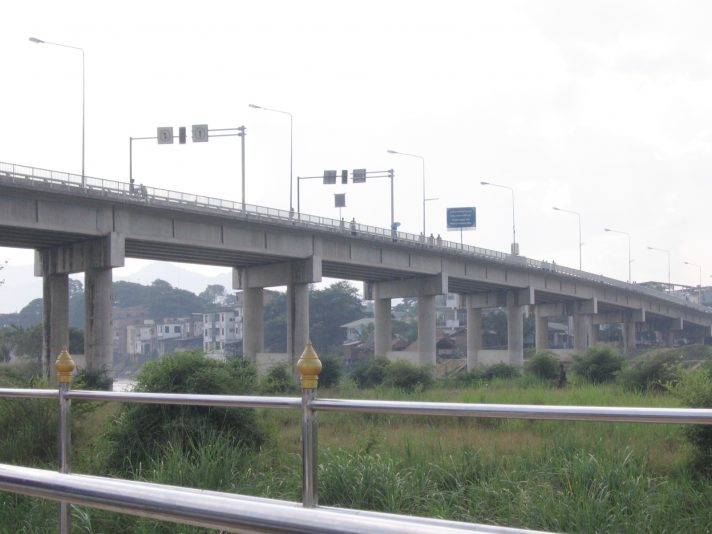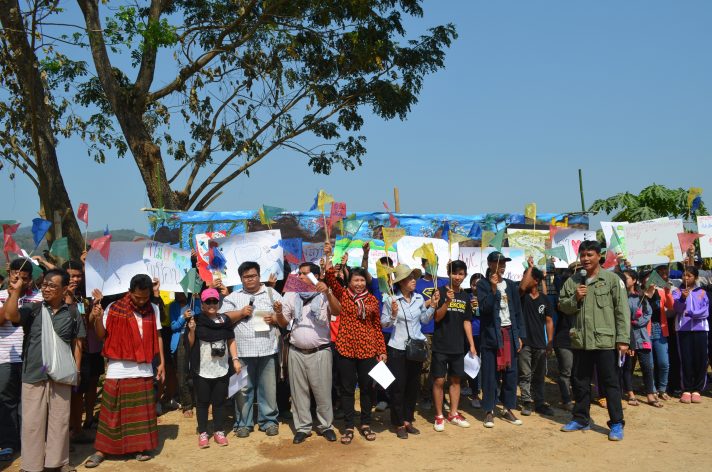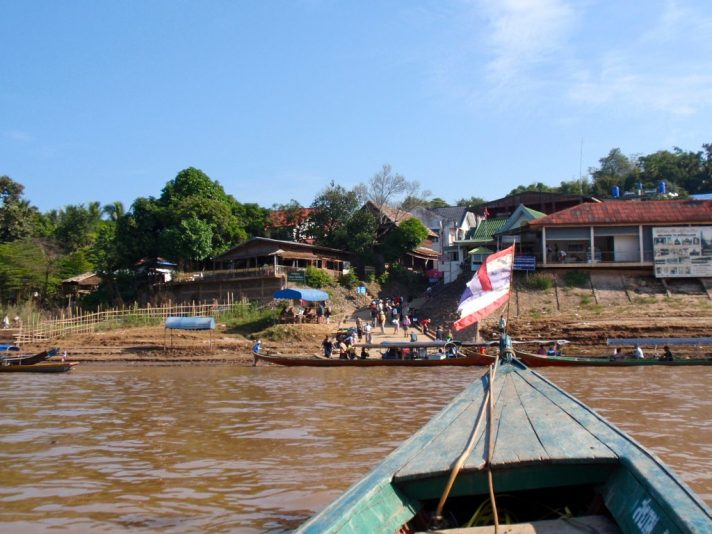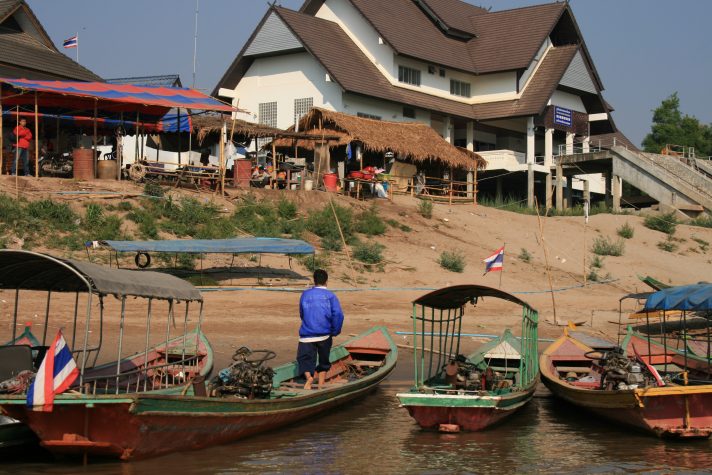Chiang Khong SEZ is a district of the Chiang Rai SEZ, all of which is located about 785 km north of Bangkok.1 This SEZ was developed here, a logistical business center for trade, to make it easier for goods to flow from China to Laos.2 It was planned by the Thai government to host agriculture and fishery, handicrafts, medical equipment and logistical businesses (eg. food processing, warehouses to support e-commerce).3 It was developed by the Industrial Estate Authority of Thailand and is under the supervision of the National Environment Board. Investors in this SEZ come from Malaysia, Singapore, Japan, Hong Kong, the United States and China.4 Due to its advantageous geographical location, the Chiang Khong SEZ is expected to be a transport hub linking several countries with various types of transportation infrastructure. A bridge, the Thai-Lao Friendship Bridge 4 was opened in 2013 linking Chiang Khong to Huay Xai, Lao PDR.5 Waterways will be connected to roads, planned to be finished by 2019.6 It will also connect Thailand, Myanmar, Lao PDR and China via the R3A highway.7
This SEZ is not yet completed, and development has been partially halted by local protests. As such, there is still relatively limited information about what is going on at the ground level at this SEZ.

The Thai Myanmar Friendship Bridge is an example of hard infrastructure. Photo by Lerdsuwa via Wikimedia. Licensed under CC BY-SA 3.0.
So far, basic infrastructure and border checkpoints at the Chiang Khong SEZ is only half complete, and urban planning is at 5/18 completion.8 After protests, the Subcommittee on Land Acquisition and Management has agreed to withdraw state-owned land acquisition, and plans to develop Chiang Rai SEZ, including Chiang Khong SEZ, using investment promotion measures, labour management and urban planning.9 No public land will be transferred to private enterprises, even though this is allowed in the Land Acquisition Act.
The entire Chiang Rai SEZ area, including Chiang Khong SEZ, benefits from investment privileges issued by the Industrial Estate Authority of Thailand. Businesses located in this SEZ will have benefits including exemption of some corporate income taxes and import duties for raw materials, 50% deductions on utility bills and transport costs, and being approved to employ unskilled foreign labour, all in the first five to ten years of investment.10 Non-tax privileges include permission to bring spouses and dependents, as well as permission to transfer foreign currency out of the Kingdom under certain conditions.11
Land
When this SEZ was first being developed, the government assigned the Treasury Department to source land to acquire for SEZ development, without public consultation or participation.12 In 2015, Boonrueng wetland and forest in the Chiang Khong district were identified for the Chiang Khong SEZ.13 However, this land was ancestral Boonrueng community lands, with a community-based natural resource management plan formalized in the 1960s.14 According to the 1967 Public Land Deeds no.2540/2510, this land was reserved for agricultural activities of the Boonrueng people.15
However, to develop the Chiang Khong SEZ, the government claimed this land under the Rachapatsadu Land Act, which states that this land should be considered ‘every kind of immovable property which is State property except…(land) reverted to the State according to the land law; and (land) in use for the people or reserved for the common use of the people such as foreshores, water-ways, highways, lakes’.16 In other words, due to a lack of clarity in the law, the government allegedly revoked land rights previously granted to the Boonrueng community.
In response, the local community formed a “Boonrueng Wetland Forest Conservation Group”, protesting against the lack of public information and consultation.17 In addition, the Boonrueng community felt that the government vision of the SEZ, as solely a boost for private investment, was contrary to their vision of an ecologically-friendly SEZ with community-based entrepreneurship, such as organic rice production.18
The community group has seen some success in their protests. In particular, the government has stopped relying on land acquisition to develop this SEZ.

CSOs and other partners meet to give thanks to the Mekong River. Photo by International Rivers via Flickr. Licensed under CC BY-NC-SA 2.0.
Migration
With any mega-project development, from dams to SEZs, the amount of land required for development displaces many people off that land. The Chairman of the Rak Chiang Khong Conservation Group has estimated that if the Chiang Khong SEZ is to be implemented, it will take at least two years for local communities to move out.19 Such a move is often initiated without proper consultation with and compensation to the communities, who lose sources of income and food in addition to land.
For the Boonrueng community, whose land is impacted by the Chiang Khong SEZ, the impact adds onto the impacts of other mega-project development in the region. For example, the community, located downstream on the Ing River, has also been affected by dam-building in the region. Upstream dams, especially those located in China, have caused erratic water level fluctuations and floods.20 Consequently, fish stocks, which used to be a source of food and income for the Boonrueng community, has shrunk. Now, the development of the Chiang Khong SEZ adds additional strain.

This is the crossing between Chiang Khong, Thailand and Huay Xai, Laos. Local communities depend greatly on this river for their livelihoods. Photo by John Pavelka via Flickr. Licensed under CC BY 2.0.
Human Rights
Although local activists have had some success in the Chiang Khong SEZ, human rights issues remain. The National Human Rights Commission of Thailand (NHRC) gathered comments from around 750 impacted people, reporting a wide range of human rights issues.21 For instance, children do not have access to quality education.22 Local workers also do not receive proper training on labour laws and safety standards, and migrant workers do not receive interpretation assistance in their workplace.23 Women are exposed to sexual violence and forced marriage.24 Drugs and intimidation by business owners are other common concerns.25
SEZs are often places where regular national laws do not apply (due to investment privileges or other incentives for investors). In addition, regulation is often limited. As such, human rights issues can be more common. However, impacted people do not have access to legal mechanisms to complain.26
Environment
The mission of the Chiang Khong SEZ is to attract logistical, agricultural and manufacturing companies. These companies may impact the delicate balance of the nearby wetland ecosystem.27 For example, the water level in the Chiang Khong region fluctuates without warning and can change overnight.28 Recent visitors have noted empty docks and river without fishing boats, while ten years ago, many fishing boats would gather at the pier daily.29
The development of SEZs exacerbates existing ecosystem damage, considered by many community members to be caused by the past 20 years of upstream dam development.30 From 2014 to 2016, a widespread drought in Chiang Khong left Boonrueng wetland with significantly less fish stocks than usual.31 Local communities attribute the cause of this to the Chinese dams upstream, which control the water volume.

Local communities engage in fishing on the Mekong River, which is the border between Thailand and Laos near Chiang Khong/Huay Xai. Photo by Akuppa John Wigham, via Flickr. Licensed under CC BY 2.0.
Waterway transportation is envisioned to play a major role at Chiang Khong SEZ. Thus, local groups are concerned about the additional impact of this water use on the river.32 Moreover, the SEZ plan to create large-scale power plants, and a warehouse and logistical center requires intense industrial development. Pollution and chemicals resulting from this development can cause severe health risks, as well as leach into water and soil, impacting fisheries and agriculture. However, these concerns remain unheard.33 Villagers trying to preserve natural resources are told that they will be compensated by the benefits and wealth brought about by the SEZ project.34 Forests are being cleared, with the government justifying it by saying that the forests are “degraded”. However, this is contradicted by research conducted by local Boonrueng people.35Currently, the local community is working with academics to appeal to the government to list the Boonrueng wetland as a valuable natural resource.
Laws
The promotion of SEZ construction and planning is sometimes at odds with other concerns, such as land, environment and labour concerns. Indeed, there are relevant regulations prohibiting arbitrary construction of building and division of land, and laws requiring scrutiny of businesses wanting to build large power projects.36 However, since the very purpose of Chiang Khong SEZ is to develop logistical centers and power plants, industrial sites are sure to be developed, which will be potentially harmful.
The 1992 Environment Act is applicable to this SEZ.37 This law indicates that environmental impact assessments are applicable to the construction of large power plants before they proceed, such as those planned in this SEZ. However, it does not guarantee that valuable resources are preserved. For example, even though some animals are protected in the Chiang Khong SEZ and the plants in the wetland are of high value, the Boonrueng community’s ancestral forest can be exempt from cleaning only if it falls in certain category of protected zones.38 Without a scientific survey, this information is not known; thus, some locals with scientific knowledge have decided to do this survey on their own.
In addition, many labour issues are addressed only in a limited way in the Labour Law. For example, while the Thai Labour Protection Act prohibits children from working in certain industries, including work related to hazardous chemicals and casinos,39 child labour remains a major issue. In the nearby Tak SEZ, trafficked child labour is rampant.40 As well, Chiang Khong SEZ’s shared border with Lao PDR means that cross-border migrant worker trafficking is a concern, as in Tak SEZ.41 Another concern is that the children of migrant workers in SEZs can become undocumented after the expiration of a parent’s visa, falling into a gap in the Thai legal system.42 Finally, the legal system allows for jobs with low protection and security. For example, migrant workers can obtain 30-day and 90-day border passes to work in non-seasonal agricultural or manufacturing jobs, and businesses have limited incentive to provide protection for such workers.43
References
- 1. Thailand Board of Investment. 2018. A Guide to Invest in the Special Economic Zones. Accessed July 16th, 2019.
- 2. Thailand PBS. 2016. “Chiang Khong Special Economic Zone” because the government does not understand Or just want cheap labor. Accessed August 8th, 2019.
- 3. Bangkok Post. 2016. Ghost town ‘forgotten’ in Chiang Khong border trade Accessed August 8th, 2019.
- 4. The Nation Thailand. 2018. Chiang Rai developer unveils major project Accessed August 8th, 2019.
- 5. Thailand Board of Investment. 2018. A Guide to Invest in the Special Economic Zones. Accessed July 16th, 2019.
- 6. Office of the National Economic and Social Development Council. n.d. Special Economic Zones in Thailand Accessed August 8th, 2019.
- 7. Bangkok Post. 2018. Chiang Khong focus of border SEZ Accessed August 8th, 2019.
- 8. Office of the National Economic and Social Development Council. n.d. Special Economic Zones in Thailand Accessed August 8th, 2019.
- 9. Ibid.
- 10. Bangkok Post. 2016. Ghost town ‘forgotten’ in Chiang Khong border trade Accessed August 8th, 2019.
- 11. Chiangrai Special Economic Zone. 2019. Investment Privileges from Industrial Estate Authority of Thailand Accessed August 8th, 2019.
- 12. Ibid.
- 13. RATCHADA ARPORNSILP and RAWEE THAWORN. 2018. Nested Interconnection: Transgressing Community-Based Natural Resource Management towards Innovating Collective Landscape Mobilization. Accessed August 8th, 2019.
- 14. Ibid.
- 15. Ibid.
- 16. Ackaratorn Chularat. 1975. RATCHAPHATSADU LAND ACT, B.E. 2518 (1975) Accessed August 8th, 2019.
- 17. Ibid.
- 18. RATCHADA ARPORNSILP and RAWEE THAWORN. 2018. Nested Interconnection: Transgressing Community-Based Natural Resource Management towards Innovating Collective Landscape Mobilization. Accessed August 8th, 2019.
- 19. Thailand PBS. 2016. “Chiang Khong Special Economic Zone” because the government does not understand Or just want cheap labor. Accessed August 8th, 2019.
- 20. Forest People Program. 2018. Protect human rights in trans-boundary investments – the message from the 2018 SEA conference on Human Rights and Business Accessed August 8th, 2019.
- 21. The National Human Rights Commission of Thailand (NHRC). 2016. Summary report on the Situation of Human Rights in 2016 Accessed August 8th, 2019.
- 22. Ibid.
- 23. Ibid.
- 24. Ibid.
- 25. Ibid.
- 26. Ibid.
- 27. Hannah Storey. 2018. Local communities must be considered when planning special economic zones – my experience with the peoples of Boonrueng. Accessed August 8th, 2019.
- 28. International Rivers. 2017. Shared Commitment to the Future of the Mekong River. Accessed August 8th, 2019.
- 29. International Rivers. 2016. A Visit to the Mother River. Accessed August 8th, 2019.
- 30. Ibid.
- 31. Bangkok Post. 2016. Northern villagers feel ‘zoned’ out. Accessed August 8th, 2019.
- 32. China Dialogue. 2018. The river ‘is not for sale’ warn Mekong villages. Accessed August 8th, 2019.
- 33. The National Human Rights Commission of Thailand (NHRC). 2016. Summary report on the Situation of Human Rights in 2016 Accessed August 8th, 2019.
- 34. Bangkok Post. 2016. Northern villagers feel ‘zoned’ out. Accessed August 8th, 2019.
- 35. Ibid.
- 36. Industrial Estate Authority of Thailand. 2013. Notification of the Industrial Estate Authority of Thailand No. 103/2556 Re: Land Development for Business Operators in Industrial Estates Accessed August 8th, 2019.
- 37. Chiang Rai Special Economic Zone. n.d. Chiang Khong district. Accessed August 8th, 2019.
- 38. Bangkok Post. 2016. Northern villagers feel ‘zoned’ out. Accessed August 8th, 2019.
- 39. National Executive Council. 1998. Labour Protection Act of 1998 Accessed August 9th, 2019.
- 40. Thai PBS. 2015. Tak province will discuss with factories for abstention of using child and illegal labor, which may affect the special border economic zone. Accessed August 9th, 2019.
- 41. Ibid.
- 42. Health Information System Development Office. 2015. Border economic zones: Two sides of the coin. Accessed August 9th, 2019.
- 43. U.S. Department of State. 2019. 2019 Trafficking in Persons Report: Thailand Accessed August 9th, 2019.

